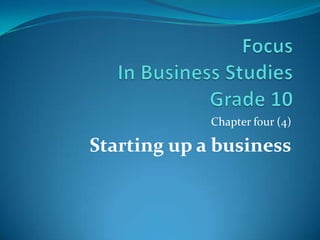
presentation
- 1. Chapter four (4) Starting up a business
- 2. Learning outcomes After studying this chapter, learners should be able to: Different routes to business ownership Identify a business ideas and opportunities Evaluate business ideas and opportunities Describe the process of starting up a business Develop a business plan Be able to do a viability study Determine the feasibility of an identified business opportunity
- 3. Introduction This lesson will be focusing on how to start up a business. First of all, if someone wants to start up a business it is important to know a background routes to business ownership of starting up a new business. Secondly it will be focusing on starting up a business process.
- 4. Different routes to business ownership There are many ways in which business ownership can be achieved. There are common methods that a person can use to establish a business. Other methods include: Buying an existing business, Taking over a family business or Buying a franchise. The following slide will discuss more about the routes to business ownership:
- 5. Starting a new business There are different options a person must consider when starting a new business: First option: to start very small business and remain small Second option: it might be small due to limited start- up funds but a business can grow up through the investment of the business profit. Third option: a person must decide to start a business at an advance level with sufficient funds.
- 6. Buying or taking over an existing business. A person can run a business from taking over from his/her family business or bought from another owner. The business continue to exist as it was when it was owned by the previous owner. For example if a son or a daughter is owning maybe a family company that was owned by his or her father before.
- 7. Buying a franchise Franchise is the guidelines that are set down by a franchisor (person who controls the right to the franchisee to sell organization's product or service). Thus franchising is granting of certain rights by a franchisor to other parties, franchisee.
- 8. Starting-up a business process Step 1: Identifying a business opportunity or ideas. The entrepreneurs must identify ideas by considering their skills and expertise. Must know what their personal strengths, knowledge and experience are. Business ideas are also generated through the problem identification.
- 9. Step 2: Evaluate feasibility of the business opportunity and idea You must identify a possible business idea and determine whether there would be a need for what he or she is thinking(for instance, who their market will be) Must identify whether he or she has necessary skills, knowledge and resources to do what is implied by the business idea. The feasibility study include evaluation of the business idea and identification of the market.
- 10. Step3: Viability study The most important thing about viability study is to determine the size of the potential market Establish the market and the need of the market. Develop the mission statement of your business. Formulate goals and objective of your business. Determine the market share of the market Estimate the income of the organization (by considering the fixed and variable cost) Calculate the break-even point (point where there is no profit and loss)
- 11. Step 4: Developing a business plan Business plan assist the business to focus in all its activities on reaching the objectives in an organized manner. When developing a business plan there are key elements of a business plan that you need to consider, here are as follows: Cover letter: addresses a person whom the business plan is addressed, it a very brief summary (one page) must attract the attention of a reader to read the rest of the business plan.
- 12. Key elements continues… Table of content: it includes the headings and sub- headings of a business plan. Executive summary: it includes two or three pages of management summary of a business plan. Description of the business: it explain exactly what type of business is planned
- 13. Key elements continues… The vision, mission, goals, objectives and strategy of the business: it provides a clear indication of the business intention. Product or service plan: the product and services must be explained
- 14. Key elements continues… Marketing plan: it explain how the product and services will be brought to the attention of the consumers. Financial plan: it explain how much money is needed to start and operate the business.
- 15. Conclusion Starting up a business is a complicated process which require an extensive analyses of business ideas, evaluation of opportunities and planning.
- 16. References Nieuwenhuizen, C. & Oosthuizen, TFJ. (2012). Business Management: a contemporary compilation. Roodepoort: Future Vision Business Consultants (FVBC). Nieman, G. (1998). The Franchise option: How to Franchise your Business. Cape Town: Juta.
